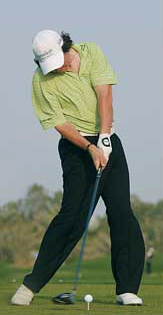In this world, you have to give a little to get a little. Baseball and tennis are difficult sports because the ball we have to hit is moving so fast. Let’s slow the ball down a little, like to a complete stop, waiting for us to hit it at our leisure. Welcome to the ground, welcome to golf.
What we gave up to get a stationary ball is the freedom to hit a little above or below the ball, and now a second dimension, behind the ball, is added. The spot the clubhead has to hit is about the size of a dime, and the clubhead will be moving at about 80 miles per hour at the time. The margin for error is gone.
Learning how to pick the ball cleanly off the ground is the hardest problem new golfers have to solve. It will haunt them well into advanced golf, and may be an issue for their entire playing career.
There’s an easy way to learn this, and if you’re willing to put in the time, you can move on from wondering if you’ll hit the ball to planning exactly where you’re going to hit it.
Get a 9-iron, drop a ball in front of you, and take a stance with your feet about six inches apart. Now just chip the ball with a backswing that is no more than two feet long. The ball doesn’t have to go anywhere, you just want to focus on clean, ball first-ground second contact.
You’ll soon be able to tell if you hit the ground first, even by just a little, and also if you missed the ground completely, even though you hit the ball reasonably well. You’ll learn, too, what the perfect strike feels like, where the ball, ground, and club all come together at just the right moment. That’s your ball striking goal.
Do this exercise for a few minutes every day. Make short swings, get clean contact. You can’t get too good at it. Once you have mastered the two-foot swing, and I truly mean mastered it, lengthen your swing, maybe by about a foot. If you have problems making clean contact, go back to the two-foot swing and gradually work back to the longer swing. This is the Madsen Rule in practice.
Keep lengthening you swing, but only when you feel you are ready to. There’s no need to rush, and there are no short-cuts. This exercise builds a lifelong habit that will produce effective golf shots to the degree that you develop your skill with it. Six months of dedicated practice will get you to where you want to go.
If you have taken your time with this exercise, working in a controlled way through longer swings, being thoroughly prepared for the the time you move up, by the time you get to your full swing, you will be the ball-striker you had hoped you would be.
My new book, The Golfing Self, is now available at www.therecreationalgolfer.com. It will change everything about the way you play.


